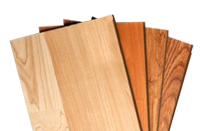What does Sheesham Wood look like?
What is Sheesham wood?
Sheesham wood originates from the Dalbergia sissoo, also known as the Indian Rosewood. It is a tree native to India and parts of the sub-Himalaya, especially Pakistan and Nepal. Due to its adaptability the tree is now grown in parts of the US, Africa and Australia and is prized for its stunning and highly practical wood, which is used for many kinds of furniture and ornate carvings.
What do the trees look like?
The Dalbergia sissoo can grow as tall as 15 metres in dry regions and when in wetter conditions it can reach 30 metres in height. It has compound leaves and yields pretty pinkish white flowers similar to pea flowers. The tree also produces dry fruit in the form of thin light brown pods.
What does Sheesham wood look like?
An overall description of Sheesham wood is that it is a hardwood, but not among the hardest in this category. In terms of appearance its colour ranges from golden brown to a deeper, reddish brown almost like a conker. The wood will often benefit from some rather striking darker streaks to give it a unique touch. Sheesham wood is a favourite with carpenters and craftsmen because it is very easy to work, carve and is not susceptible to termites or splitting and cracking when turned. In short the wood is tough, hardy and beautiful and can feature some intricate interlocking grains.
The appearance of Sheesham wood – a detailed exploration
While the heartwood of the tree can vary between golden and darker reddish brown the sapwood is the colour of golden straw and is sometimes added to furniture – although this is thought to be more to do with its relative cheapness rather than anything it adds aesthetically – which is a happy accident. Sheesham Wood benefits from an excellent natural lustre, meaning that it can be finished with natural beeswax and does not need anything too fancy to bring out its exceptional natural beauty,
In terms of its endgrain, Sheesham wood is characterised as diffuse porous, meaning it has relatively few, large pores with no specific arrangement and it also benefits from gums and other heartwood deposits with a reddish brown colouration. These are fairly common in their occurrence. Sheesham wood is rated between durable and very durable and benefits from excellent decay resistence.
As touched upon before Sheesham wood is prized for its workability and it is because of the combination of many of the characteristics it benefits from. The only pieces of Sheesham wood that are harder to work with machines are those rare pieces with interlocked grain as these can rip during surfacing.
One of the amazing things about Sheesham wood, like the other woods in the Dalbergia genus, is its distinctive scent. The Sheesham scent is much more pleasant than its cousins as it is not as strong, while still retaining enough of an aroma to be interesting.
Because the tree itself tends to be rather crooked in its growth, long sections of timber are relatively scarce. This makes the wood more suited to certain kinds of furniture and less suited to, for example church benches, or other pieces requiring great length. The species from which Sheesham comes is not endangered and is considered sustainable in its cultivation. The wood is held in a very high regard in India, especially, where it is believed to benefit from spiritually auspicious properties as well as great colour, density and durability. As such it is valuable in India, but remains relatively affordable in Europe.
All of these many attributes come together to make Sheesham wood very desirable for furniture, turned objects, veneer and percussive musical instruments.


